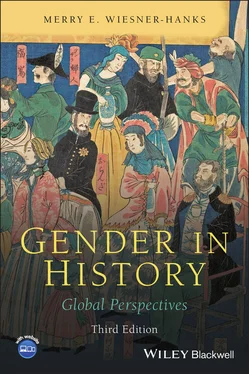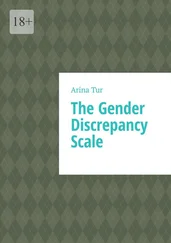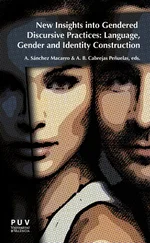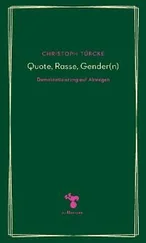New theoretical perspectives are adding additional complexity and bringing in still more questions. One of these is queer theory, which was developed in the early 1990s – a period of intense HIV-AIDS activism – by scholars in several different fields who combined elements of gay and lesbian studies with other concepts originating in literary and feminist analysis. Queer theorists argued that sexual notions were central to all aspects of culture, and called for greater attention to sexuality that was at odds with whatever was defined as “normal.” They asserted that the line between “normal” and “abnormal” was always socially constructed, however, and that, in fact, all gender and sexual categories were artificial and changing. Some theorists celebrated all efforts at blurring or bending categories, viewing any sort of identity as both false and oppressive and celebrating hybridity and performance. Others had doubts about this, wondering whether one can work to end discrimination against women, African Americans, gay people, or any other group, if one denies that the group has an essential identity, something that makes its members clearly women or African American or gay. In the past several decades, queer theory has been widely applied, as scholars have “queered” – that is, called into question the categories used to describe and analyze – the nation, race, religion, and other topics along with gender and sexuality. This broadening has led some – including a few of the founders of the field – to wonder whether queer theory loses its punch when everything is queer, but it continues to be an influential theoretical perspective.
Related questions about identity, subjectivity, and the cultural construction of difference have also emerged from postcolonial theory and critical race theory. Postcolonial history and theory were initially associated with South Asian scholars and the book series Subaltern Studies, and focused on people who have been subordinated (the meaning of subaltern) by virtue of their race, class, culture, or language as part of the process of colonization and imperialism in the modern world. Critical race theory developed in the 1980s as an outgrowth (and critique) of the civil rights movement combined with ideas derived from critical legal studies, a radical group of legal scholars who argued that supposedly neutral legal concepts such as the individual or meritocracy actually masked power relationships. Historians of Europe and the United States are increasingly applying insights from both of these theoretical schools to their own work, particularly as they investigate subordinate groups such as racial and ethnic minorities. World historians also now often use ideas developed by postcolonial theorists to analyze relationships of power in all chronological periods, not simply eras of imperialism.
An important concept in much postcolonial and critical race theory has been the notion of hegemony, initially developed by the Italian political theorist Antonio Gramsci. Today hegemony and domination are often used interchangeably, but in Gramsci’s view, they are not the same. Hegemony involves convincing dominated groups to acquiesce to the desires and systems of the dominators through cultural as well as military and political means. Generally this was accomplished by granting special powers and privileges to some individuals and groups from among the subordinated population, or by convincing them through education or other forms of socialization that the new system was beneficial or preferable. The notion of hegemony explains why small groups of people have been able to maintain control over much larger populations without constant rebellion and protest, though some scholars have argued that the emphasis on hegemony downplays the ability of subjugated peoples to recognize the power realities in which they are enmeshed and to shape their own history. Many historians have used the concept of hegemony to examine the role of high-status women, who gained power over subordinate men and women through their relationships with high-status men, and thus paid little attention to or chose not to protest their own subordination to men. The Australian sociologist R. W. Connell has also applied the idea of hegemony to studies of masculinity, noting that in every culture one form of masculinity is hegemonic, but men who are excluded from that particular form still benefit from male privilege, which they exploit rather than opposing the men who have power over them.
Both postcolonial and critical race theory point out that racial, ethnic, and other hierarchies are deeply rooted social and cultural principles, not simply aberrations that can be remedied by laws protecting individuals from discriminaton. They note that along with disenfranchising certain groups, such hierarchies privilege certain groups, a phenomenon that is analyzed under the rubric of critical white studies. (This is a pattern similar to the growth of men’s studies out of women’s studies, and there is a parallel development in the historical study of heterosexuality, which has grown out of LGBT history.) Unsurprisingly, such explorations of white privilege and structural racism have proven threatening to some, with conservative political and media figures, especially in the United States, stoking white rage with broad attacks on critical race theory, and state legislatures passing bans on anti-racism instruction or even any discussion of systemic racism in the schools.
Queer theory, postcolonial studies, and critical race theory have all been criticized from both inside and outside for falling into the pattern set by traditional history, that is, regarding the male experience as normative and paying insufficient attention to gender differences. These criticisms led to theoretical perspectives that attempt to recognize multiple lines of difference and their intersections, such as critical race feminism and Third World and transnational feminism. Both Third World feminism, which developed in the 1970s, and transnational feminism, which developed in the 1990s, critique the underpinnings of colonialism, imperialism, and nationalism, including those that contributed to the rise of Western feminism in its various waves. Drawing on postcolonial history and theory, transnational feminist scholars have focused on processes of subordination, relations between gender and power across boundaries defined by nations, individual and institutional cross-border networks and dynamics, the impact of global migration on family life, gendered and sexualized nationality, affective and intimate relationships in imperial contexts, and many other topics. Such scholarship has begun to influence many areas of gender studies, even those that do not deal explicitly with race or colonialism. It appears that this cross-fertilization will continue, as issues of difference and identity are clearly key topics for historians in the ever more connected twenty-first-century world.
Gender History as a Field
This discussion of scholarly trends may make it appear as if using gender as a category of analysis has swept the discipline of history, with scholars simply choosing the approach or topic they prefer. This is far from the actual situation. There are still many historians who continue to view focusing on gender as a new-fangled fad, or, conversely, as an old-fashioned approach no longer needed in postfeminist world. As noted above, until very recently, books that explicitly take a world, global, or transnational perspective have focused largely on economic and political developments without examining their gendered nature. Other historians invoke “gender” without really thinking through its implications for their interpretations of the past. Though titles like “man the artist” have largely disappeared, as most authors – or their editors – have recognized their false universality, books still divide their subjects into “artists” and “women artists” or “rulers” and “women rulers.”
Читать дальше












